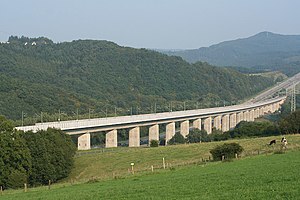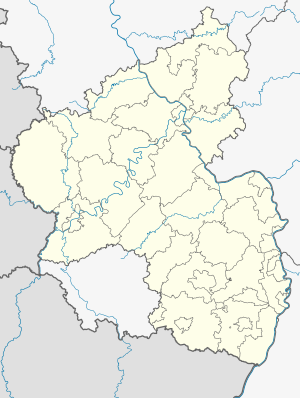Hallerbachtal Bridge
Coordinates: 50 ° 37 '22 " N , 7 ° 23' 36" E
| Hallerbachtal Bridge | ||
|---|---|---|
| View from the north end of the bridge | ||
| use | Railway bridge | |
| Convicted | High-speed route Cologne – Rhine / Main | |
| Subjugated | Hallerbach | |
| place | Neustadt (Wied) | |
| construction | Prestressed concrete - box girder bridge | |
| overall length | 992 m | |
| Longest span | 40 m | |
| start of building | October 1998 | |
| completion | 2000 | |
| opening | 2002 | |
| location | ||
|
|
||
The Hallerbachtal bridge is a railway bridge at route km 50 of the high-speed line Cologne – Rhine / Main . It crosses the valley of the Hallerbach near Neustadt (Wied) .
overview
With a length of 992 meters, it is the longest of 18 larger bridges on the new line , which make up 2.9 percent of the total route. The route rises in the area of the Hallerbachtal bridge in the direction of Cologne by up to 40 per mille; it is part of a several kilometer long ascent with a total of 170 vertical meters. The overpass structure is located at a maximum height of 33 meters above the valley floor and up to 24 meters above the level of the Federal Motorway 3, which runs parallel to the east . The Hallerbachtal Bridge is one of the railway bridges in Germany with the greatest longitudinal incline. The spans of the 25-span girder bridge are 40 meters, only the end spans have a span of 32 meters or 38 meters.
The minimum longitudinal incline is one percent.
The bridge takes on two tracks on a slab track of the Walter-Heilit type with two-block sleepers, which can be driven on as planned at 300 km / h. To the south of the structure, after a short earthwork section, the Wiedtalbrücke (54 meters) is the highest bridge on the route in a tight curve. The Günterscheid tunnel follows to the north .
Although the bridge is often cited as a negative example of bridge construction aesthetics due to its high superstructure and narrow pillar spacing, many images were taken from the top of the bridge looking south to promote the high-speed line and high-speed traffic.
Due to problems with the stability of the noise barriers, the speed in the area of the bridge was reduced to 230 km / h for several months in the first half of 2006, at times also 200 km / h or only 160 km / h.
history
planning
At the end of 1995, the planned length of the structure was 992 m, which was realized later.
construction
Construction work began in October 1998.
The structure was built with a 196 t advancing armor. A total of 17,320 m³ of concrete , 2,500 t of concrete and 430 t of prestressing steel were required for the construction (other source: 14,000 m³ of concrete, 7000 t of slack steel and 360 t of prestressing steel). For the superstructure alone, 10,250 m³ (26,600 tons) of concrete were required. After a construction period of 20 months, the Hallerbachtal Bridge was completed in September 2000. The superstructure was completed in May 2000, and the installation of overhead line masts and noise protection walls followed in autumn of the same year.
20 of the 24 pillars are founded on nine large bored piles each with a diameter of 1.50 m. The remaining pillars and the abutments were founded flat .
Most of the construction work on the bridge was completed in mid-2001. Noise barriers and catenary masts were installed, the installation of the contact line was still pending.
Driving experience

The area around the Hallerbachtal bridge is considered by railway enthusiasts to be a highlight of the new line. The rapid succession of tunnels, bridges and curves as well as slopes and inclines of up to 40 ‰ at 300 km / h parallel to the six-lane motorway is perceived as a special driving experience and jokingly referred to as the fastest roller coaster in the world .
From the direction of Cologne, the ICE 3 can for the first time reach the top speed of 300 km / h on the approximately five-kilometer-long downhill gradient in the area in front of the bridge. Within a few seconds, there is a transition from maximum acceleration to controlled braking in order not to exceed the maximum speed on a downhill slope. Shortly afterwards, in a right turn on the ascent of the Wiedtal bridge, the full drive power is required again to stabilize the speed. Meanwhile, the road traffic on the lower-lying motorway is regularly overtaken.
In the opposite direction, the increase slows trains from 300 km / h, the top speed is often reached here for the last time before the next stop in Siegburg / Bonn or Cologne.
Individual evidence
- ↑ a b c d Cologne / Bonn Airport; Mouse guest; Successful completion of the bow; Limburg ICE train station; Idstein tunnel . In: On the subject , ZDB -ID 2115698-0 , edition 3/2000, June 2000, pp. 7-9.
- ↑ a b c d In 12 seconds over the Hallerbachtal . In: On the subject , ZDB -ID 2115698-0 , edition 4/2001, August 2001, pp. 9-11.
- ↑ Alexander von Wilcken, Walter Fleischer, Hagen Lieschke: Production of slab track Rheda type Walter-Heilit with two-block sleeper, on the Cologne – Rhein / Main line . In: Railway technical review . 51, No. 4, 2002, pp. 172-182.
- ^ Roland Fricke, Jochen Zech, Ellen Hunold, Jürgen Menzel: Bridges between Siegburg and Dierdorf . In: New Cologne – Rhein / Main line. Bridges and tunnels . DB ProjektBau GmbH, Frankfurt (ed.), 2001, without ISBN, pp. 18–23.
- ^ Deutsche Bahn AG, network division, project management for the Cologne – Rhein / Main line (publisher): route map for the new Cologne-Rhein / Main line . Map from November 1995, Frankfurt 1995
- ↑ Hallerbachtalbrücke ( Memento from March 1, 2006 in the Internet Archive ) on arge-nbs.de
- ↑ a b Without author: The project for the new Cologne – Rhein / Main line . In: Eisenbahn JOURNAL: Tempo 300 - The new Cologne – Frankfurt line . In: Eisenbahn Journal , special edition 3/2002, ISBN 3-89610-095-5 , pp. 34–63
- ^ Max Bögl GmbH & Co KG: Engineering structures of the Cologne-Rhein / Main line ( Memento from September 28, 2007 in the Internet Archive ) (PDF; 4.4 MB), p. 6 f.
Web links
- Information and pictures about the construction ( Memento from March 1, 2006 in the Internet Archive )
- Hallerbach Viaduct. In: Structurae




